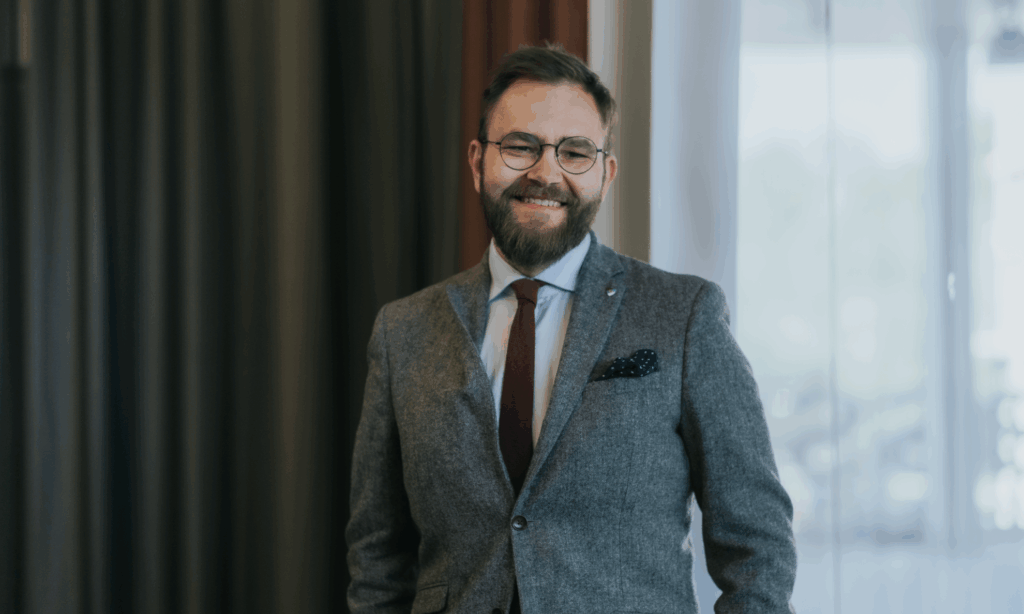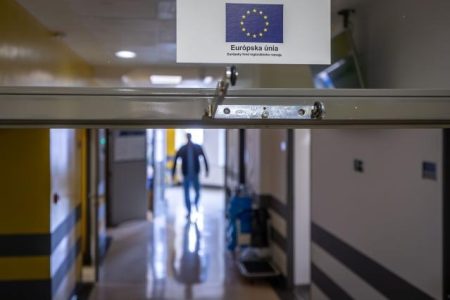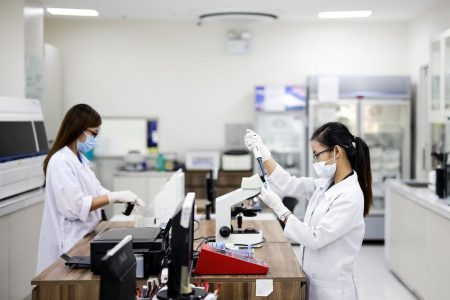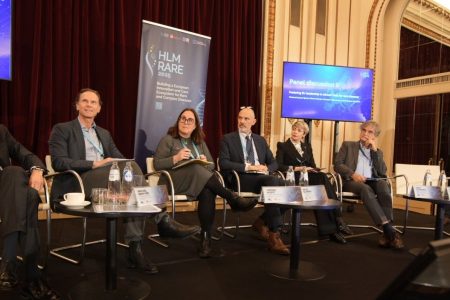My name is Tomasz Grybek. First—and foremost—I’m a father of a child living with a rare disease called metachromatic leukodystrophy. My son, Borys, is now a sixteen-year-old teenager, and we also have a younger daughter, Greta—she’s our sweetie and Borys’s little sister.
The second “hat” I wear is my professional capacity: by training, I’m an economist, and I work as a quality and food safety manager in the food sector.
The third capacity I have is patient advocacy, which I took on thanks to—or because of—Borys and his journey. I serve as a patient representative to ERN-ITHACA and MetabERN, and I’m also involved on the EURORDIS Board of Directors. I act as a patient representative at the European Medicines Agency (EMA), specifically on the Paediatric Committee (PDCO). In my advocacy work, I focus on strategic and systemic planning—regulatory processes, strategic planning, programme development, and policy activities—trying to bring a process-oriented approach to address the needs of the rare disease community. It’s my real passion, and it’s a pleasure to serve our big community of rare disease families and patients.
The Polish National Mirror Group (NMG) launch seems imminent. How could it influence policies and research at both at both national and EU level?
National Mirror Groups are key facilitators of the exchange of practices and knowledge between the European Union and its Member States. This is of paramount importance to build on past good examples, but also to avoid mistakes made by others.
What steps should Poland take to integrate effectively into the broader European rare disease research system?
I think that Poland is already on a good path to be more integrated with the European rare disease ecosystem. We do our utmost to be a real partner, and I think it will certainly accelerate and broaden Poland’s integration within the European ecosystem of rare diseases. It is an effort worth making.
As you know, ERDERA supports collaborative research to work towards earlier diagnoses and better understanding of rare diseases among patients, families, and society at large. How big do you think the knowledge gap is, and what needs to happen to bridge it?
I think it’s huge, but also very interconnected. One big hurdle is that many people—professionals, policymakers, society—tend to look at someone with a rare disease purely through the lens of that condition, missing the bigger picture of the person’s life.
We need systemic planning and policies that account for rare diseases across all areas—healthcare, social services, education, employment—and that are continuously evaluated and improved. If we only tackle these issues disjointedly, we lose the chance for long-term, consistent progress.
When we do strategic planning at the European level—whether it’s in healthcare, research, or social policy—we need to ensure that rare diseases are always part of the conversation. That’s the real gap: a coordinated, cross-sector approach. With a solid plan, measurable goals, and continuous re-evaluation, we could make a big impact.
You mentioned your son, Borys—could you tell us a little bit more about his condition? How did you find out about the diagnosis, and how did things develop from there?
Borys has metachromatic leukodystrophy—a rare neurological disease, specifically a lysosomal storage disorder. It’s a genetic condition, autosomal recessive, so he was born with it, but the onset of visible symptoms came when he was around five.
Before that, he developed like any regular child, without obvious symptoms. At about five-and-a-half, we noticed he was having some issues with walking and speech, which triggered our path toward getting a diagnosis. In many cases, people living with rare diseases go through a very long diagnostic odyssey. Ours was relatively short and efficient by comparison. We got a clear diagnosis that it was metachromatic leukodystrophy.
What followed next was more of a “treatment odyssey” because, at the time, there wasn’t an officially approved treatment. We tried to learn about clinical trials in Milan and Paris, but Borys’s disease progression was quite fast. We even flew to the United States, hoping to be enrolled in a bone marrow transplant programme, which was considered good clinical practice for this disease back then.
Ultimately, a professor in Poland contacted us, saying he could do a bone marrow transplant in our home country. So at age six, Borys underwent an allogeneic stem cell transplant from an unrelated donor. He was the first child in Poland with this disease to receive such a transplant.
Now, it’s ten years post-transplant, and the progression of his disease has been arrested. Borys is a happy teenager—he’s into jazz music, he loves visiting museums, spending time outdoors… He’s a great brother at home and he enjoys his life as much as possible.
It’s surprising that Borys received a relatively quick diagnosis, because many people with rare diseases don’t. How much of a difference do you think it makes to have an early diagnosis, and how did it impact your case?
An early diagnosis makes an enormous difference. In many of these conditions, newborn screening can be crucial. For instance, in metachromatic leukodystrophy, there is now a gene therapy with conditional marketing authorisation in Europe, but it works best when paired with newborn screening so you can intervene before symptoms arise.
In our situation, simply having a diagnosis changed everything because, without it, no one can even begin to talk about care or treatment pathways. We were able to reach out to various hospitals, clinical trial centres, and patient communities around the world. It opened doors for us and gave us a direction. Without a diagnosis, you’re just stuck in this large pool of “undiagnosed” patients, and you can’t move forward effectively.
Early diagnosis saved crucial time and possibly saved Borys’s life, because we could pursue a treatment option that was available at the time. It also allowed us to plan—if there was no treatment, at least we could prepare ourselves and adapt our daily lives, careers, and activities. When there is a treatment available, the benefit of getting that diagnosis as early as possible can be transformative.
From a policy perspective, it underscores the importance of having unified and coherent newborn screening programmes across Europe. This would give every child the best possible chance at early intervention and support.
You’re not only a parent but also a caregiver. What key aspects do you think are essential for caring for someone with a rare disease?
One point I always emphasise is this: people living with rare diseases are far more than their disease. It’s an important part of their life, but it’s not everything. They have passions, hobbies, dreams, frustrations—everything that comes with being human.
As caregivers, we must manage the daily challenges—medications, medical appointments, assistive devices—but we also shouldn’t forget about living a fulfilling life. Spending time with friends, having fun, going out, or following personal interests—these things are essential for everyone.
Another critical aspect is community support. Feeling alone is very common for people living with rare diseases and their families. It’s vital to have a strong network of professionals, family, friends, and wider social support because these diseases can be isolating.
Finally, everyone has the right to live as independently as possible. Just because a person has a rare disease doesn’t mean they don’t deserve the same opportunities and freedoms as anyone else. That can be overlooked sometimes, so it’s a message I keep repeating: focus on inclusion, community, and respect for a person’s full life, not just the diagnosis.
As someone who juggles multiple roles—father, professional in quality and food safety management, policy work, patient advocacy, and so on, how has it been moving from one role to another, and what experience do you bring from each sphere?
All these roles feed into each other. From my professional life in quality assurance, I bring a strong process-oriented mindset—strategic planning, measuring outcomes, continuous improvement. That intersects well with advocacy, where we need systemic solutions and accountability.
Being a father of a child with a rare disease gives me the very personal, firsthand perspective, which keeps me grounded in what families really need. And my work on regulatory and public policy committees gives me insight into how systems are structured, where the bottlenecks are, and how we might fix them.
Blending these perspectives helps me be more effective in each role. It feels synergistic—what I learn in one capacity informs the others. Ultimately, it’s all aimed at improving the ecosystem for people living with rare diseases.
Looking ahead at what these collaborative research projects like ERDERA can achieve in the next seven years, how can it truly impact the lives of people with rare diseases and their communities?
Collaboration is absolutely key. Rare diseases are, by definition, less common, so it’s nearly impossible for one country or one centre to know everything about every condition. Coordinating across Europe—across the world, really—lets us pool knowledge and resources, from basic research to clinical trials to patient registries.
ERDERA has a crucial leadership role to play. It can serve as a systemic plan—bringing in various stakeholders, ensuring everyone is heard, and fostering a continuous cycle of planning, doing, checking, and acting. If it’s done well, it could create a ripple effect, inspiring other initiatives and aligning policies and practices throughout the region.
We need to use the expertise within ERDERA wisely and also collaborate with regulatory bodies, academic institutions, private sector partners, and NGOs. Ideally, it could be a model of how to align large-scale, cross-border research with real patient needs, so that the knowledge gained is translated into tangible benefits—new therapies, better care pathways, and real support for families.
Let’s end on a broader note: from your perspective, what do you think is the main message society should keep in mind about rare diseases?
No one should have to walk alone. That’s the essence. People with rare diseases are part of our community; they have the same needs and rights as anyone else—to live life fully, with joy, friendships, and opportunities. We shouldn’t define people solely by their condition.
We need consistent awareness, day in and day out—thinking about our neighbours, coworkers, relatives who might be living with a rare disease. In my local community, for example, we organise a yearly jazz concert on Rare Disease Day—not to talk about the disease all the time, but to celebrate life together, just as anyone else would.
People living with rare diseases deserve to live as independently as possible, with the same freedoms. Ultimately, it’s all about inclusion and awareness.





